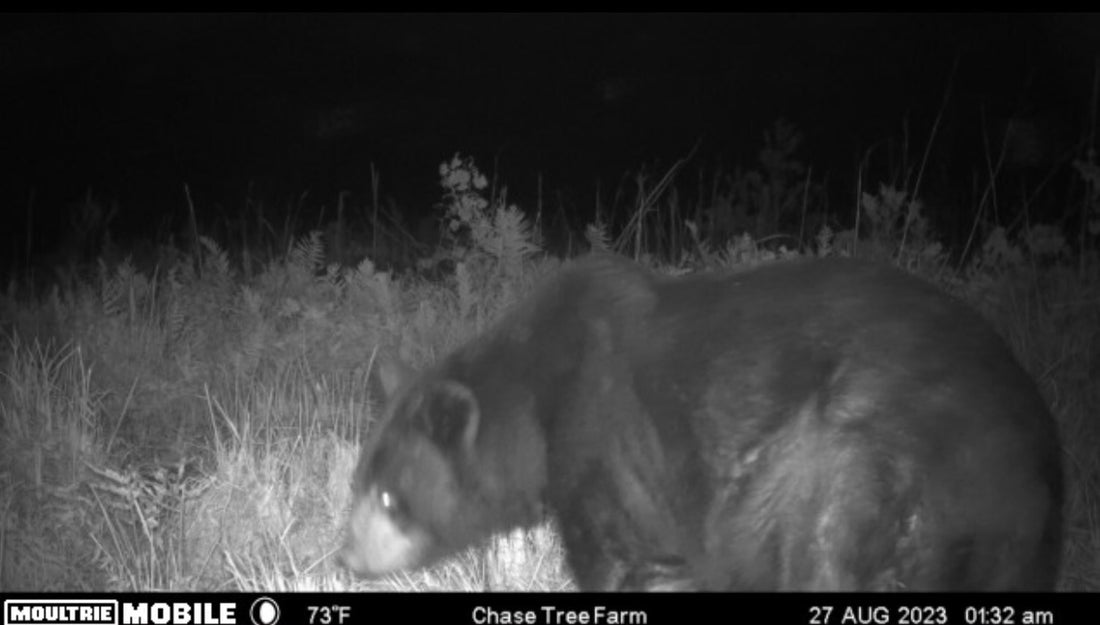
feeding the wildlife backyard and hunting ground
Share
At Flowing Well Tree Farm, we believe in creating spaces that benefit not only us but also the wildlife that shares our environment. Planting trees that support local ecosystems helps provide food, shelter, and nesting sites for various species, from birds and pollinators to small mammals. Here, we highlight four fantastic trees that are great for wildlife: Sawtooth Oak, Elderberry, Hog Plum, and Mulberry. These trees are not only beautiful additions to any landscape but also play vital roles in sustaining local wildlife.
1. Sawtooth Oak (Quercus acutissima)
The Sawtooth Oak is a magnificent tree known for its broad, spreading canopy and deeply lobed leaves that resemble a saw's teeth, giving it its name. Native to Asia but widely naturalized in the United States, this oak is a favorite among wildlife enthusiasts for several reasons:
- Food Source: The Sawtooth Oak produces acorns that mature in late summer to early fall. These acorns are a crucial food source for various wildlife species, including deer, turkeys, squirrels, and many bird species. Unlike many other oaks that take years to produce acorns, the Sawtooth Oak starts bearing them at a younger age, making it a reliable and early food source.
- Habitat and Shelter: Its dense foliage provides excellent cover for birds and small mammals. The sturdy branches are ideal for nesting, while the leaf litter beneath the tree offers habitat for insects and other invertebrates, supporting the food web.
2. Elderberry (Sambucus nigra subsp. canadensis)
Elderberry is a deciduous shrub or small tree that boasts clusters of tiny white flowers in the spring and dark purple-black berries in late summer. This native plant is a powerhouse for attracting and supporting wildlife:
- Food Source: The elderberry’s berries are a favorite for birds like robins, cedar waxwings, and bluebirds. They are also a valuable food source for small mammals such as raccoons and squirrels. The flowers attract pollinators, including bees and butterflies, creating a bustling ecosystem around the tree.
- Nesting and Habitat: The dense branching structure provides excellent nesting sites for small birds and cover for wildlife. Elderberry can grow in thickets, offering both food and shelter, making it a multi-purpose plant for wildlife gardens.
3. Hog Plum (Spondias dulcis)
Hog Plum, also known as Yellow Mombin or Ambarella, is a lesser-known but highly beneficial native tree for wildlife. It is a small to medium-sized tree with a wide canopy that produces clusters of small, yellow fruits.
- Food Source: The fruit of the Hog Plum is eaten by various animals, including deer, birds, and even some reptiles. The fruit's high sugar content provides energy to wildlife, making it a popular food source when in season.
- Attracts Pollinators: In addition to its fruit, the Hog Plum’s flowers attract a variety of pollinators, including bees and butterflies, which are essential for a thriving ecosystem. This helps promote biodiversity in your landscape.
4. Mulberry (Morus spp.)
Mulberry trees are fast-growing, deciduous trees that produce an abundance of sweet, dark berries. They are incredibly versatile and beneficial for wildlife:
- Food Source: Mulberries are a magnet for birds such as orioles, blue jays, and woodpeckers. The tree’s fruiting period, which stretches from early summer to mid-summer, provides a crucial food source during a time when other fruits are not yet ripe. Additionally, small mammals, like raccoons and opossums, are also drawn to mulberries.
- Habitat Benefits: The broad leaves and strong branches provide nesting sites and cover for various bird species. The tree also supports many insects, which in turn provide food for insectivorous birds, creating a complete mini-ecosystem.
Why Plant Wildlife-Friendly Trees?
By choosing trees that support local wildlife, you help create a balanced and thriving ecosystem in your backyard or community. These trees provide essential resources that help sustain birds, mammals, and pollinators, all of which are vital to maintaining the health of our environment. Moreover, trees like Sawtooth Oak, Elderberry, Hog Plum, and Mulberry add natural beauty to any landscape while contributing to conservation efforts.
At Flowing Well Tree Farm, we are committed to providing you with a selection of trees that benefit both your landscape and the wildlife that depends on it. Visit us to explore these and other native and wildlife-friendly trees to help you build a sustainable and vibrant garden.
Plant with Purpose. Grow with Us.
Visit Flowing Well Tree Farm today!
